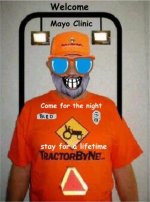I think that what is happening to your tractor is what you want to happen, and here is why:
1. Without a pressure reliefs, the engine would be stalling all the time whenever the required torque to spin any or all of the pumps goes too high. Every time a cylinder hit the end of its travel or the tractor was unable to pull or push something any harder, the engine would stall. (or a hose or seal might pop). This would make it hard to use.
2. If the sum of all the PRV's was set to never exceed the available engine torque, then the engine would never stall, but you could never deliver full engine torque to any one part of the tractor. Say we divided the torque evenly between HST, steering, and loader. Each would always have a mximum of 1/3 of the available torque of the engine. The loader would be whimpy, the push/pull would not be very useful, and your steering would be imitating JClark's machine.
3. So the compromise is to set each PRV slightly below stalling torque. Say maybe 80%. Any one system can be used with nearly the full power of the engine and still have a minimal amount of remaining torque to at least run the other systems with no load. But, if you max out more than one system at a time, the engine stalls.
4. Many one-pump (not including the HST) systems give "priority" to the steering. This is kind of a safety thing. You wouldn't want the steering to stop working while the tractor happily chugged off the side of the road.
5. Like the I-match system, you could have one of the other systems back-off its load if the engine starts to stall. On I-match, they chose to back off the HST. A very good idea when running a tiller or a loader. You can still get full power to the implement, you just move slower.
Many tractors are in situation 3. Some are in 4. Some newer tractors have situation 5.
- Rick

